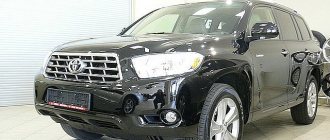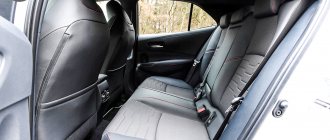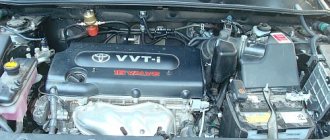All owner reviews about Toyota Camry XV30
Before that, I drove an A100 transitional cigar, I drove a lot (but did not use) a Merc 190, a Hyundai Lantra, a Merc w140 (diesel), I rode a little in a 3rd Pajero, a couple of Lexuses. A year has passed of living together with this car. I bought it second hand and the mileage was shown to be 230 thousand km. I am inclined to believe what is drawn (if they twisted it, it wasn’t very much). The previous owner turned out to be a very good owner - the car did not cause any special problems after him. I am especially grateful for the small tuning - there was a metal mesh between the bumper and the lower edge of the radiators (bought on the construction market for less than $1 - thanks to this, the radiator package was always clean, not broken by stones, etc. The car also had non-original springs ( I suspect that they are from a Toyota Highlander) - i.e. they fit perfectly into the seats - no spacers, etc. - but the car was significantly higher. At times this made me happy (trips into nature, parking on the lawn near the house, etc.), at times it was frustrating (the handling was not so great, the steering wheel bit slightly when you smoothly and slowly return it back, and most importantly, when crossing speed bumps, if no one was sitting behind them, the rear shock absorbers expanded to the extreme position and the rebound was clearly felt - it was annoying - I had to move carefully) .
In terms of operation, the car did not keep tension (although it has driven less than 30,000 km so far) - from time to time I stopped at stations and looked at the suspension (in a year I changed parts for $33 (thirty-three) - although I don’t particularly care about potholes - and in matters of car maintenance it’s better I won’t buy that thread for myself, but I’ll fix it), immediately after the purchase I changed the abs sensor (it wasn’t working when I bought it) - a little expensive ($150) and I had to wait 2 weeks for it to be delivered (I ordered a new one) and the driver’s seat belt buckle (the spring broke there - The lock is not removable - a new Toyota one - 20 euros - basically not expensive - I ordered it together with an abs sensor).
About 20 thousand later it started working loudly - I stopped at a service station - the corrugation had rotted. I drove like this for a month - no one wanted to undertake the work (the V6 engine took half a day of work) - in general, I did it poorly (I had to remove it, go to the market to pick it up, go to another place to weld it, and then install it at a service station - everything was ok on another machine - thanks helped my father). I changed the rear brakes a couple of times. pads ($25 original for both wheels! - funny). Oil (every 10 thousand synthetic 5w-50), filters all with oil (about $20 a set, salon $30 - haven’t changed it yet - not recommended for the winter). It would be nice to change the battery - but here the toad is constantly choking - after all, it starts up, why change it. I changed the belts (it squeaked in wet weather when you start up) (I haven’t changed the timing belt yet) - one bolt went sour - I struggled with it for a long time - in the end, in half a day of work, a kind man dismantled the floor of the engine, turned out a new bolt - installed it - no longer squeaks . Well, the light bulbs are all around. Oil in the machine with a filter.
Review of Toyota Camry 3.0i 24v (2004)
Hi all.
Last August I bought a 2004 Camry 3.0 liter. I wanted one from the moment they were first released, but at that time I didn’t have enough money. When the opportunity arose, I bought it. I asked him from a classmate, he works at the Toyota Center in tinsmithing and painting. The car came up for sale through the tradein system, he looked at it and bought it in May, and he spilled the beans to me. I'm on fire! I WANT, pestered him - give it back. He needed to solve a housing problem, and that was the solution. I bought it and go.
The first owner of the car drove with a driver, mostly on the highway. Therefore, after the purchase, my classmate changed all the links, silent blocks, rubber bands, etc. on the suspension. I replaced all the racks with the original ones. It would be possible to ride on those, but in winter the rear ones collapsed to the bump stops on the waves and then the car swayed slightly. With a mileage of 126,000, the original struts weren’t even sweating!? I changed all the accessories, even the front springs. I thought that the front would rise a lot, but no, not much. But I had one problem - after replacing the struts, they did a wheel alignment, and after a couple of days I feel like I’m pulling to the left. I came to the service again. “You did something wrong,” I say. There they remade it without any questions, but in the end they said that in general this always happens when you install new springs, after a couple of days they sit down under the weight of the car and mine, so the toe-in is gone. Now everything is smooth.
A month later, I began to notice that a slight metallic knock appeared on small irregularities, as if something was unwinding. I took it to a service center, they looked all over, a mechanic took it for a ride, they said, leave the car alone, everything is fine. But I hear a knock. I sat my son next to him, he also hears (damn, these aren’t auditory glitches). The technicians at another service checked everything again and found nothing. The entire suspension, they say, is almost like new. I'll wait, maybe the knocking will come out somewhere (although I don't like it when something knocks). The knock is heard only on small bumps. Has anyone encountered this? It is clear that there are a lot of things that can knock, but what besides the suspension?
I won’t write much about comfort (apart from the knocks described above) so as not to tire anyone, a lot has been written before me - it swallows holes, doesn’t ride, but floats. The new struts definitely hold the road better. I drove to Chelyabinsk along the highway, accelerated to 140 (no need for anything else). I thought that I would feel the sail, as I read in many reviews here, but I didn’t feel it, and that’s okay. I rarely drive at this speed, unless I need to speed up when overtaking. It is not for racing, but for a comfortable ride.
The seats are comfortable and your back doesn't get tired at all. The only pity is that they are leather. Until I left the skin, in the cold, even in a warm car, the skin is like frozen metal, and the heating only works if you sit down yourself. The bad thing is that the heating has only two positions - on or off. There are as many as 5 of them in focus - very convenient!
The trunk is just huge, I’ll go fishing and see how much stuff will fit in there. It’s a shame that in such a car there is no handle on the inner lining of the trunk to close it when it’s dirty—you don’t want to get your hands dirty, and pulling the lock—the plastic lining there is slippery.
Noise insulation is not so great, but still better than that of the Focus. I will change the acoustics, and at the same time I will make some noise.
The salon is spacious. The best thing about a seven-year-old car is that there are no crickets! Only the leather of the seats creaks. The finishing materials suit me quite well.
Handling is normal. What can you expect? On tires 215/65 R16 it couldn’t be any other way. Walking, but all this for the sake of a comfortable ride, one must assume. I agree, so be it, but it doesn’t shake your brain like a Focus or Honda Accord.
Fuel consumption. This is the most painful issue for the 3-liter engine. In winter around the city with warm temperatures and traffic jams it is 19.6. It’s warm now, I barely warm it up - 16.2. On the highway on cruise control - 9.6 (105 km/h), if you press the pedal yourself - 8.8-9.2, depending on the terrain. The fuel sensor is strangely configured, I fill it up and drive until the lamp comes on; when refueling, only 60 liters enter, with a tank volume of 70 liters. It turns out that there is another 10 liters on the burning lamp. splashing, where is so much?
Reliability: tfu-tfu, never let you down. And all the Toyotas I've owned have not let me down. The worst thing that happened was that the low beam lamp burned out. By the way, about the headlights - the light is good, but the headlights themselves seemed to have darkened... it’s not clear whether they were smoky on the inside or dirty on the outside, and I noticed this in all 30 bodies. In the 40, the headlights are as clear as crystal, but these...
In general, I like the car, I don’t regret buying it. Minor shortcomings don’t count, I’ll fix some things over time, I’ll come to terms with some things. And I’ll ride it for at least a couple of years. These were still made by engineers, but the new ones were made by marketers. Friends who replaced the 30 with the 40 regretted it: the handling is better, but the comfort is not that great.
Good luck to everyone on the roads.
Is it worth buying a used Toyota Camry 30
The youngest top 30 turns 12 this year. Thus, find this model with a mileage of less than 200 thousand. kilometers is very difficult. This means that unexpected expenses await you at any moment. For example, in terms of walking. Fortunately, you still need to try to “add” 30. These cars can survive a million kilometers and then continue to drive. The main thing is to carry out maintenance on time. Change oils and filters for all engines every 7-10 thousand km/or once a year, whichever comes sooner, change the oil in a manual transmission every 60 thousand, and 40 thousand in an automatic transmission. Every 100 maximum 150 thousand km change the timing belt in 3.0 V6. The inline 2.4 is equipped with a timing chain drive. The chain is designed for the entire life of the car. For American 30-k, in-line 2.0, V6 3.0 and 3.3 were also offered.
Yes, of course, the motors are reliable, but they are also gluttonous. 2.4 manual will be the most economical 10-12 liters in the urban cycle, automatic and more powerful V6 will require from 13 to 15 liters of fuel per hundred. Nevertheless, you can save on refueling thanks to the installation of LPG, which gets along well with all Kamryushka engines.
At high speeds, say over 140, you can roll the car. When cornering at high speed or making sharp maneuvers, unpleasant rolls occur, and when braking sharply, body dives occur. Plus the steering is very light, which also does not contribute to fast, aggressive driving. But no one in Camry even talked about sports! This is a business class sedan. With a comfortable soft suspension that copes very well with our travesty of the roads. And the light steering will be pleasant when maneuvering in the city and in tight alleys.
The model also leaves a pleasant, positive impression of itself with its large, spacious interior, which can accommodate 5 passengers in decent comfort. And thanks to the rich range of options, even in the base, a trip in this car will be very pleasant. Plus a whole range of security systems, good sound insulation, good ergonomic button placement and high-quality plastic.
Even in the worst condition, it is quite difficult to buy a 30 in Ukraine today for less than $6,000. And if you do buy one, get ready to immediately spend hundreds of dollars on repairs. It's better not to buy such a copy. For a normal 5th generation Toyota Camry you will have to pay at least 8,000 thousand dollars. And in general, good 30s pass from one close hand to another close one. But if you are lucky, you will find yourself in the “fat”! Quality, reliability, comfort and brand status are what the Japanese manufacturer Toyota is based on, especially with its Camry model. And when you decide to sell this car, you won't have to wait long for a buyer. Since the model is very liquid. It doesn’t matter what configuration, what year of manufacture and in what condition.
We watch more interesting videos on the Test Fat channel on Youtube.
Reviews
The very first thing I drew in my life was a car - I’m sure of it, and I think my mother did too. I've been very passionate about them ever since and have spent years understanding body types, engines, makes and models. I learned a lot. In turn, I even managed to teach some of my acquaintances how to understand brands and correctly describe and characterize cars. But I hardly know the technical part of a car, I don’t know how to drive it (only a motorcycle). I don't know if I'm good with cars. But discussing the latest in the automotive world and automotive design has been our favorite pastime for several years now. To a greater extent (and maybe completely) this was facilitated by one television program, or rather the show - Top Gear. NTV, advertising a program about cars. Living in the village, I did not have the opportunity to learn anything about the automotive world (lack of money to buy magazines, lack of Internet, four TV channels). And I didn’t miss the chance - I started waking up at ten in the morning to look at three men having a blast worse than Jim Carrey in a studio full of people and cars - funny. As they say, I'm hooked. The world of expensive and beautiful cars has finally opened up for me. And to this day I never stop watching Top Gear episodes with trepidation and a wide smile on my face. Why does this program attract so many people (sometimes not at all knowledgeable about cars)? First of all - presentation. Where else can you see a similar program about cars, in which the presenters do nothing but make fun of each other, make faces, burn tires and come up with absolutely absurd things (tests for cars, for example)? Nowhere! All these remakes are just sad parodies that make you throw the remote control at the TV screen. Another very striking feature is the photography. Incredibly bright feature. From season to season, the picture progresses more and more, turning watching the program into watching the most beautiful action! Exactly! Action! English humor mixed with the most gorgeous angles, deepest colors and various effects will not leave anyone indifferent! As for car fans. Nevertheless, they do not remain in the air. Behind the jokes and action lies a detailed, and most importantly, ACCESSIBLE description of each tested car. At the same time, various interesting car parts are shown in close-up. The presenter will also specifically highlight the main pros and cons of the car, tell (in some cases) even the history of its creation, etc. You just have to either agree with him or not. But to disagree with him is to be an idiot... :) I would like to note that in earlier releases of the program, tests were carried out on ordinary, mother's, grandfather's and teenagers' cars. Over time, it went away - but to be honest, it didn’t make it any worse. Top Gear is top gear, which means cars should be top gear. And cheap cars now appear in various special editions. Presenters: Jeremy Clarkson, an excellent journalist, a doctor (May thinks so), does not like Porsches, likes to burn rubber while making faces, uses a bucket as a motorcycle helmet. Richard Hammond, a miniature version of a middle-aged playboy with sparkling white teeth, is a lover of old cars and loves to rummage through them in his free time. James May, a careful driver, a conservative, loves his Boxter, clean cars and long hair; speed record-breaker in the Bugatti Vayron Stig, a manual Top Gear racer. There are many legends about him, some of which are absolutely fantastic, like “He sleeps like a bat, upside down.” But these are all rumors, the only fact is that his name is Stig. Top Gear is a program that, I’m sure, changed the lives of very, very many people, changing the attitude towards cars, the attitude towards the British, the attitude towards television in general. A program that everyone should watch, if only because there is a lot of interesting, beautiful and, of course, funny in it :) 10 out of 10










